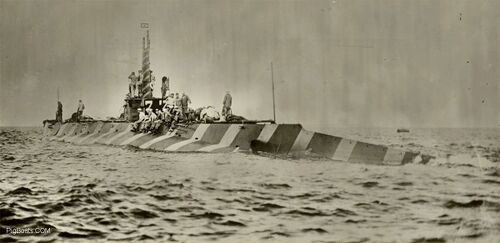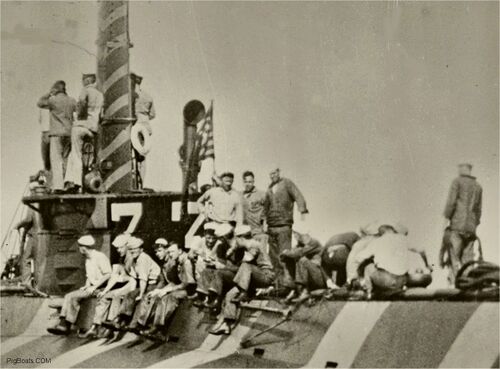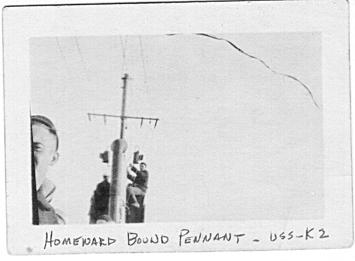K-2: Difference between revisions
Pbcjohnston (talk | contribs) Rewrote notes section and reordered photos |
Pbcjohnston (talk | contribs) Added new Header |
||
| (5 intermediate revisions by the same user not shown) | |||
| Line 1: | Line 1: | ||
[[File: | [[File:New Header 1 K-class.jpg]] | ||
=== <big>Notes</big> === | === <big>Notes</big> === | ||
| Line 10: | Line 10: | ||
[[File:K-2 in stripes.jpg|left|500px]] | [[File:K-2 in stripes.jpg|left|500px]] | ||
USS K-2 in WW I era "Dazzle" camouflage. Photo taken at Key West, FL. circa 1917. This boat and others were used to test WW I camouflage schemes at Key West prior to the U.S. involvement in WW I. Three types of stripes were used, small, medium, and large. The odd paint schemes were intended to make it much harder for an enemy to accurately determine course, speed, and range, all vital elements in a torpedo or gun fire control solution. All of these schemes made the boats more visible and were of dubious value in confusing the enemy, so it was decided that gray was a good color to blend in with the seas. The boats that went overseas had the basic haze gray paint scheme. | |||
<small>Photo in the private collection of Ric Hedman</small> | <small>Photo negative in the private collection of Ric Hedman</small> | ||
[[File:Red bar sub new.jpg]] | |||
[[File:K-2 in stripes upclose3.jpg|left|500px]] | [[File:K-2 in stripes upclose3.jpg|left|500px]] | ||
[[File: | The K-2 crew sitting on deck waiting to handle lines when needed. A group of men are working on something on deck to the right. On the right another man is standing with the two halves of a heaving line at the ready in his hands. On the deck is the after radio mast. Seen center photo on the hull is some sort of bracket hinged to the hull. | ||
<small>Photo negative in the private collection of Ric Hedman</small> | |||
[[File:Red bar sub new.jpg]] | |||
[[File:K-2 moored.jpg|left|500px]] | [[File:K-2 moored.jpg|left|500px]] | ||
K-2 moored to the monitor USS Tonopah (BM-10) in the Azores in 1918. The old monitor was acting as a submarine tender for the deployed submarines, mostly because her low deck made it easy access to the small submarines. | |||
<small>Photo provided by Cliff Leverette, grandson of Norman McKinnon who served aboard the K-2.</small> | |||
[[File:Red bar sub new.jpg]] | |||
[[File:K-2 bow.jpg|left|500px]] | [[File:K-2 bow.jpg|left|500px]] | ||
The bow of the K-2 as she headed home from the Azores, November 1918. The wires strung form the forward mast are radio aerials. These large antennas were needed by the low-powered radio sets of the day. | |||
<small>Photo provided by Cliff Leverette, grandson of Norman McKinnon who served aboard the K-2.</small> | |||
[[File:Red bar sub new.jpg]] | |||
[[File:K-2 pennant.jpg|left|500px]] | [[File:K-2 pennant.jpg|left|500px]] | ||
The Homeward Bound Pennant being raised on the K-2, November, 1918 as she crossed the Atlantic on her journey home from the war. A Homeward Bound Pennant is a long-held tradition in the USN. The pennants are usually made by the crew. They are red, white, and blue and quite thin. Oftentimes they were so long they had to be held aloft by balloons to keep them from dragging in the water. Raising one was a joyous occasion for a crew, as it meant that they were finally on their way to home and family. | |||
<small>Photo provided by Cliff Leverette, grandson of Norman McKinnon who served aboard the K-2.</small> | |||
[[File:Red bar sub new.jpg]] | |||
[[File:K-2 at Philly.jpg|left|500px]] | [[File:K-2 at Philly.jpg|left|500px]] | ||
K-2 seen here at the Philadelphia Navy Yard circa 1920. The K-2 was decommissioned in 1923. | |||
This is just a detail from a much larger photo that shows seven other submarines of various classes undergoing maintenance. There appears to be another K-class submarine inboard the K-2. Work is being done on the conning tower fairwater and the periscopes have been pulled. | |||
To the left in the photo several horses are seen that were used for pulling carts and wagons in the yard. An unidentified class of warship is seen in the foreground. It seems to be mounting several 3 or 4-inch guns. | |||
<small>Photo in the private collection of Ric Hedman.</small> | |||
[[File:Red bar sub new.jpg]] | [[File:Red bar sub new.jpg]] | ||
Latest revision as of 18:54, 13 March 2025
Notes
Boomerang
Adrift on a Disabled Submarine

USS K-2 in WW I era "Dazzle" camouflage. Photo taken at Key West, FL. circa 1917. This boat and others were used to test WW I camouflage schemes at Key West prior to the U.S. involvement in WW I. Three types of stripes were used, small, medium, and large. The odd paint schemes were intended to make it much harder for an enemy to accurately determine course, speed, and range, all vital elements in a torpedo or gun fire control solution. All of these schemes made the boats more visible and were of dubious value in confusing the enemy, so it was decided that gray was a good color to blend in with the seas. The boats that went overseas had the basic haze gray paint scheme.
Photo negative in the private collection of Ric Hedman

The K-2 crew sitting on deck waiting to handle lines when needed. A group of men are working on something on deck to the right. On the right another man is standing with the two halves of a heaving line at the ready in his hands. On the deck is the after radio mast. Seen center photo on the hull is some sort of bracket hinged to the hull.
Photo negative in the private collection of Ric Hedman

K-2 moored to the monitor USS Tonopah (BM-10) in the Azores in 1918. The old monitor was acting as a submarine tender for the deployed submarines, mostly because her low deck made it easy access to the small submarines.
Photo provided by Cliff Leverette, grandson of Norman McKinnon who served aboard the K-2.

The bow of the K-2 as she headed home from the Azores, November 1918. The wires strung form the forward mast are radio aerials. These large antennas were needed by the low-powered radio sets of the day.
Photo provided by Cliff Leverette, grandson of Norman McKinnon who served aboard the K-2.

The Homeward Bound Pennant being raised on the K-2, November, 1918 as she crossed the Atlantic on her journey home from the war. A Homeward Bound Pennant is a long-held tradition in the USN. The pennants are usually made by the crew. They are red, white, and blue and quite thin. Oftentimes they were so long they had to be held aloft by balloons to keep them from dragging in the water. Raising one was a joyous occasion for a crew, as it meant that they were finally on their way to home and family.
Photo provided by Cliff Leverette, grandson of Norman McKinnon who served aboard the K-2.

K-2 seen here at the Philadelphia Navy Yard circa 1920. The K-2 was decommissioned in 1923.
This is just a detail from a much larger photo that shows seven other submarines of various classes undergoing maintenance. There appears to be another K-class submarine inboard the K-2. Work is being done on the conning tower fairwater and the periscopes have been pulled.
To the left in the photo several horses are seen that were used for pulling carts and wagons in the yard. An unidentified class of warship is seen in the foreground. It seems to be mounting several 3 or 4-inch guns.
Photo in the private collection of Ric Hedman.
Page created by:
Ric Hedman & David Johnston
1999 - 2023 - PigBoats.COM©
Mountlake Terrace, WA, Norfolk, VA
webmaster at pigboats dot com
